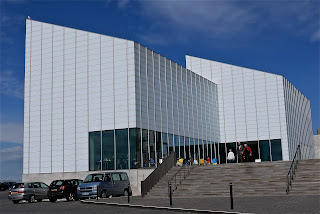Margate Station
It's my birthday and we have come to Whitstable for a gourmet fish dinner, but first to Margate to see an exhibition at the Turner Contemporary gallery called Turner and the Elements. Obviously this requires a town walk around Margate and we were thrilled to find a map and Heritage walk on the Turner Contemporary site to give us some pointers.
We went by train and the walk starts very conveniently at the station. This turns out to be an early work by the Modernist architect Maxwell Fry, designed before he had fully shaken off his classical training.
From here we walked to the sea front and looked across the beach towards the Stone Pier. The sand was noticeably fine-grained, but the beach is surprisingly small.
Walking along the esplanade you come to the clock built for Queen Victoria's Jubilee in 1887. It put us in mind of the more elaborate one in Weymouth, built for George III's jubilee.
Further round the esplanade we followed Market St to foray into the Old Town. We quite liked the old Town Hall of 1820 ("drab" according to Pevsner) and were amused that the pub beyond it was included in the heritage trail - because the comedian Eric Morecambe married the landlord's daughter. We thought this was carrying the concept of heritage a bit too far.
We returned to the sea front and walked to the end of the Stone Pier, which dates from 1810-15, passing former coal stores now converted into shops. At the end is the bronze Shell Lady, by Ann Carrington, which depicts Turner's long-suffering mistress Sophia Booth.
At the town end of the pier is the Droit House of 1812 where harbour dues were once collected. A plaque explains that the original building was destroyed during the war, but was rebuilt in 1947.
Opposite stands the stark, but imposing Turner Contemporary gallery designed by David Chipperfield Architects.
Inside, the gallery is spacious and the seaward side has a dramatic group of tall windows with a curiously compelling view out to sea. The area is famous for its light, highly valued by Turner, and is both effective and appropriate to make it a feature of the building.
We were now running out of time and perhaps did not give the rest of Margate the attention it deserved. We walked up past the gallery to the Winter Garden and downhill to King St where we detoured to find a surprising and rather incongruous restored 16th house - known, perhaps inevitably, as the Tudor House.
The section of King Street nearer the sea had a nice Georgian/Victorian appearance.
Now we we returned to the sea front and retraced our steps to the station. I see from Pevsner that we missed The India House of 1767, "the best house in Margate" and Drapers' Almshouses of 1708.
Conditions: warm and sunny.
Distance: about 3 miles.
Rating: three and half stars. Much more interesting thab might have been feared.









No comments:
Post a Comment